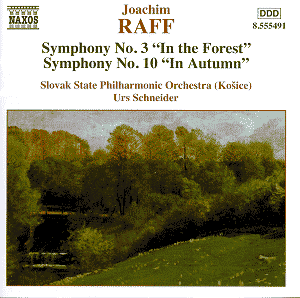This is a CD of warm, mellow, transparently clear,
well-written music noted for its lasting attractiveness and class, impeccable
craftsmanship, subtle orchestration, sound structure. This is music
that is controlled and which also contains evocative and memorable melodies.
This is, to quote an hackneyed phrase, music for music's sake; no ostentation.
But perhaps that is the drawback and so there are reservations.
The seasonal link between these two symphonies will
appear obvious (Raff’s symphonies 8 to 11 depict the four seasons).
The Symphony no. 10 is the better work although the finale of number
3 is commendable. The Tenth Symphony is rich in pastoral shades of music.
The opening had an infectious descending theme in a dotted rhythm that
goes back to where it came from. The music is obviously programme music
as the title for the movement is Impressions and Feelings. Of
course, we do not know what his feelings were as conveyed in the music.
However unacademic this comment is, the music is naive, pretty and innocent
and you can sometimes feel the autumn in the air, the long shadows,
and recall those autumnal times when the sunlight on your face is golden.
The Symphony no. 10 dates from 1879 when Raff was in
Frankfurt. This is lovely music, mellow and expertly scored. And I still
wonder what exactly was in Raff's mind and what pictures of rural life
he is intending to conjure up. At the time he was working too hard (it
was hard work that killed him) and I expect he missed the countryside.
The second movement is called Ghost's Dance which is very controlled
music but not sinister. Obviously these ghosts are friendly and mere
wisps of vapour. The charm and elegance of the first movement is still
here but the first indication of strength in the music comes briefly
to the fore. In this performance the music is probably too controlled.
Nothing is unleashed and Mendelssohn's ghost is there.
The third movement is a large adagio which some have
suggested represents the fall of the year or the decline in the weather.
To me, it sounds like Tchaikovsky ballet music. Tchaikovsky was the
composer of grand light music and this lightness is in Raff's music
but without the schmaltz. Raff's music is divertimento music, immensely
attractive but, perhaps, superficial and lacking in dramatic contrast.
To complete the Tchaikovsky comparison one can detect hints of the Russian's
Symphony no. 5 but the Tchaikovsky was written a decade later. This
slow movement is a little too long.
Perhaps Raff's music is sweet although it is not sickly.
The finale of this symphony is mildly robust albeit somewhat predictable
to depict this doubtful pastime. It is a jolly (at times) movement with
the obligatory horns. Did Raff approve of, or enjoy hunting? The hunt
is briefly introduced then disappears and it is later that we catch
up with it and there is some excitement. But, alas, the music is still
controlled and polished and I am sure huntsmen get muddy and sweaty!
The Symphony no. 3 is entitled In the Forest and
is divided into three sections. The first is entitled By Day and
also called Impressions and Feelings - as is the first movement
of the Tenth. This is either dreary or lazy music depending on which
way you hear it. It meanders rather than inspires. It is quite pleasant
but needs more onward motion than this performance gives. It reaches
few climaxes and the music is somewhat tame. But at 14 minutes this
movement is too long. It is like driving along a straight flat road
on a level plain. Although the sun is shining and it is pleasant day
there is nothing else. I have heard Raff's music called snuggly music!
Only when the movement is 12 minutes old does anything happen!
In fact Raff's music lacks tension and, therefore,
to some extent, conviction. In an obscure way, Schubert is recalled.
Schubert wrote pretty little tunes which he repeated over and over again
and, often, that is all there is to Schubert. Perhaps Raff is a bit
like that although his material and technique is vastly superior.
Part two is entitled Twilight and Dreaming which
is uneventful music and the Dance of Dryads is a wisp of music.
Part three is sometimes big and brash (Raff's style). I missed the stillness
of night section ... how? The wild hunt was just that. At last, the
music has real purpose and is expertly written with some wonderful orchestration.
The music subsides into a portrayal of daybreak but there is some noble
music as well. But I must stress it is noble music devoid of that awful
British Edwardian pomposity.
There is a lot of dislike of programme music apparently
because it puts a strain on the listener to try to decipher what this
bit means and what that bit means. In addition, there are some charlatans
who explain the meaning of some programme music. This is wildly accepted,
as some scientists have wildly accepted another fraudulent ‘missing
link’, only for the composer to come up and state something completely
different. Just enjoy the music!
The recorded sound is excellent on this disc.
David Wright
‘See David
Wright's essay on Raff on this website’

